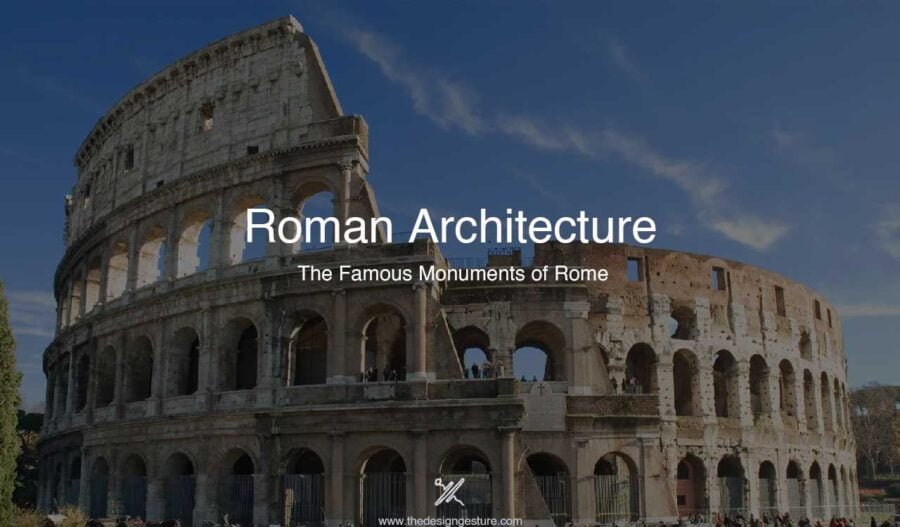Table of Contents
Introduction
Italy offers a wide range of architectural styles. The Italian Architecture has had a significant impact on the architecture of the rest of the globe. Italy is known for its significant architectural achievements, including the construction of aqueducts, temples, and similar structures during ancient Rome, the founding of the Renaissance architectural movement in the late-14th to early 16th centuries, and being the birthplace of Palladianism, a style of construction that inspired movements such as Neoclassical architecture and influenced the designs that noblemen built their country houses all over the world, particularly in the United States.
Italy’s architectural style cannot be classified by period or area because of the country’s separation into small states until 1861. As a result, an extremely broad and eclectic range of architectural designs has resulted.
Furthermore, from the 19th century, the term “Italianate architecture” has been used to designate foreign building that was erected in an Italian style, particularly modeled on Renaissance architecture.
Italy is home to several of Western architecture’s finest achievements, including the Colosseum, Milan’s Duomo, Turin’s Mole Antonelliana, Florence’s cathedral, and Venice’s building designs. Museums, castles, buildings, statues, churches, art galleries, villas, fountains, historic dwellings, and archaeological remnants are among the estimated 100,000 monuments in Italy. With modern architects like Renzo Piano and Carlo Mollino, Italy is now at the forefront of modernist and environmental design.
History
Along with prehistoric architecture, the Greeks and Etruscans were the first people in Italy to actually establish a succession of styles. The Etruscans led the way in building in Northern and Central Italy during the period.
Etruscan Architecture
The Etruscans used brick and wood to construct their structures. The Etruscans influenced Roman architecture by constructing temples, fora, public avenues, aqueducts, and city gates. With the exception of a couple in Volterra, Tuscany, and Perugia, Umbria, few Etruscan architectural sites are presently visible in Italy.
Greek Architecture
The Greek colonists who founded Magna Graecia in southern Italy built their buildings in their own style beginning in the eighth century BC. They created larger, better, and more technologically advanced homes, which had an impact on Roman architecture as well. However, during the 4th century BC, when the Hellenistic Age began, less emphasis was placed on the construction of temples and more time was devoted to the construction of theatres. The semi-circular theatre had an auditorium and a stage. Unlike the Romans, who erected the audience seats artificially, they used to be built solely on hills.
Bulky stone or marble pillars were commonplace in Greek temples. Several ruins of Greek construction may still be seen in Italy, particularly in Calabria, Apulia, and Sicily. The Valle Dei Templi temples, which are now U.N.E.S.CO. World Heritage Sites are a good example.
Italian architecture was affected by Greek architecture, which left substantial indications in Magna Grecia, in the temples of Agrigento, Selinunte, and Paestum, and by Etruscan building, which attracted Vitruvius’ attention.
The Romans assimilated Greek influence, which can be observed in many parts of architecture, such as the introduction and usage of the triclinium as a location and way of dining in Roman villas.
Similarly, the Romans owed their Etruscan neighbors a debt of gratitude for providing them with a plethora of information necessary for future architectural solutions such as hydraulics and arch construction.
Types of Architectural Styles
Byzantine Architecture
In Italy, Byzantine architecture was also commonly employed. The Byzantines were the global leaders in terms of culture, arts, music, literature, fashion, science, technology, business, and architecture until the Western Roman Empire collapsed in 476 AD. Since the Byzantines occupied Sicily for a time, their architectural influence may still be seen today, for example, in the elaborately painted churches of Cefalu, Palermo, and Monreale. In Venice, St Mark’s Basilica is another example of Byzantine architecture.
The Byzantines, who were officially the inhabitants of the Eastern Roman Empire, preserved Roman architectural and artistic ideas while giving them an Eastern twist. They were known for their somewhat flatter domes and fuller use of golden mosaics.
The art and architecture of the early Christians were heavily influenced by that of the pagan Romans; sculptures, mosaics, and paintings adorned all of their churches. Late-Christian frescoes can be seen in several of Rome’s many catacombs.
The basilica is a Christian idea that originated in Rome. They were notable for having large, rectangular structures with mosaics and embellishments, created in an almost archaic Roman style.
Romanesque Architecture
The Romanesque movement, which lasted from around 800 to 1100 AD, fell between the Byzantine and Gothic periods. The use of Roman arches, stained glass windows, and curving columns, all of which are prevalent in cloisters, earned the design the name “Roman”-esque. The Leaning Tower of Pisa at Piazza Dei Miracoli and the Basilica of Sant’Ambrogio in Milan were erected during this time, which was one of the most productive and inventive periods in Italian architecture.
The style and structure of Romanesque architecture in Italy varied widely. The Lombard Romanesque was more structurally advanced than the Tuscan, but less artistically. The weight of the buildings caused them to buckle on the exterior, and they were employed as buttresses to support the structures. Unlike the magnificent mosaics seen in Italian Byzantine architectural works, they were simply made of marble or stone and had a minimal design.
The vault was the most important invention in Italian Romanesque architecture.
Gothic Architecture
In Italy, as in many other European nations, Gothic architecture was imported. In the 12th century, Gothic architecture first arose in Italy. The evolution of Italian Gothic was always marked by a distinctive feature that distinguished it from that of French Gothic, where it had begun. The dramatic architectural solutions and technological advances of the French Gothic never occurred in Italy, since architects opted to stick to the centuries-old construction tradition.
The Benedictine Cistercian order was the principal bearer of this new architectural style, thanks to their new edifices.
Rennaissance Architecture
The Renaissance flourished in the 15th century in Italy, particularly in Florence. The academic approach to ancient architecture corresponded with a widespread resurgence of learning. Florence was the birthplace of the new architectural style, which was purposefully brought into being by specific architects who intended to restore the order of a prior “Golden Age,” rather than gradually emerging as Gothic did from Romanesque.
Forms that were clearly defined and structural features that communicated their purpose were always chosen by Italian architects. These traits may be observed in many Tuscan Romanesque buildings, such as the Florence Baptistery and Pisa Cathedral.
Mannerist Architecture
Mannerism is a word used to describe some features of creative style, mostly Italian, between the early 16th century High Renaissance and the early 17th century’s beginnings of Baroque art. Mannerism arose and flourished in several areas until the Baroque style emerged around the end of the 16th century. Many of the High Renaissance’s concepts were incompatible with mannerism. It was marked by high intricacy, complexity, and innovation rather than harmony, clarity, and rest.
Mannerist architects were just as interested in old classical architecture as their forefathers, but they discovered new traits in the ancient Roman buildings that they could use.
Baroque Architecture
The Palazzina di Caccia di Stupinigi (Hunting Lodge of Stupinigi), built in the 18th century, is one of the unique masterpieces of late Baroque architecture. It was created by Filippo Juvarra, who also built the Basilica di Superga in Turin, and has a highly articulated plant based on a Saint Andrew’s Cross.
Rococo Architecture
Italians were more interested in the work of Francesco Borromini, a baroque architect, in the early 18th century. Several designers, such as Filippo Juvarra, were influenced by this style during this time period but strove to make it more graceful, lighter, and less oppressive than High Baroque.
Swelling, curving shapes, terra-cotta construction, exposed components, and intricate architectural compositions were all hallmarks of this new style, which was popularised by various Northern Italian architects. In addition, the interaction between structure and light was emphasized.
Neoclassical Architecture (the 1750s–1850s)
The term “Italian Neoclassical Architecture” refers to architecture from the Neoclassical period in Italy. Milanese Neoclassical architecture comprises the primary aesthetic trend in the city from around 1750 to 1850. Luigi Cagnola’s Arco della Pace (Milan), the San Carlo Theatre (Naples, 1810), San Francesco di Paolo (Naples, 1817), Pedrocchi Café (Padua, 1816), Tempio Canoviano (Posagno, 1819), Teatro Carlo Felice (Genoa, 1827), and the Cisternone (Genoa, 1827) are examples of Neoclassical architecture in Italy (Livorno, 1829).
Art Nouveau Architecture
Giuseppe Sommaruga and Ernesto Basile were the most important and original exponents of Art Nouveau, often known as the Liberty style in Italy. The first designed Milan’s Palazzo Castiglioni, while the second planned enlargement of Rome’s Palazzo Montecitorio.
Fascist Architecture
The rationalist-Fascist architectural style was an Italian architectural style that emerged during the Fascist government, especially in the late 1920s. Two branches have been identified: a modernist branch led by Giuseppe Terragni, and a conservative branch led by Marcello Piacentini and the La Barbera group.
Post-W.W.II Architecture
Appliances, furnishings, flooring, and facades that followed mass-production from factories were put on hold during the immediate post-World War II-style explosion in the 1950s. This made it easy for general contractors to support the brutalist movement by building in the suburbs.
Modernist Architecture
Modernism, often known as modern architecture, is a style of architecture that originated in the early twentieth century. Following the devastation of World War II, modernism would emerge as the dominant architectural style.
Architecture Master’s Courses in Italy
In comparison to their Western European rivals, Italian universities are quite economical, and the quality of education is clear. Italy has always been and continues to be a cultural and educational cradle. In reality, the Institution of Bologna, which was founded in 1088, is Europe’s oldest university. The standout fields where Italian institutions are second to none are fashion and architecture, but there are other English-taught degrees to select from. In your leisure time, you may take advantage of the pleasant Mediterranean environment, the sea air, and delectable cuisine while touring historic monuments such as Rome’s Colosseum and Pantheon.
Courses:
SOS Master Program- SOS School of Sustainability, Milano, Italy
Industrial Design for Architecture- POLI, Design- Milan, Italy
Architecture for Heritage- Turin, Italy
Architecture Construction City- Turin, Italy
Best Examples of Italian Architecture
Rome’s Villa d’Este
The grounds of Renaissance nobility and Cardinal Ippolito d’Este’s pleasure house are laced with whimsical grottoes, flowing flumes, and reflecting ponds.
Rome’s Pantheon
The best-preserved and most exquisite ancient edifice in Rome — if not the globe — was erected and perhaps planned by Hadrian between 118 and 125 A.D., and is capped with a 44-meter-wide (143-foot) concrete dome that has never been structurally changed.
Brunelleschi’s Dome, Florence Santa Maria del Fiore, Florence
Filippo Brunelleschi’s distinctive dome is one of the world’s most stunning examples of Renaissance architecture, and as you slip between the inner and exterior domes on your way to the top, you’ll get a personal look at the unique double-shell construction.
Pisa’s Leaning Tower
The term “Pisa” brings up pictures of an elaborate white marble cylinder leaning against a beautiful blue sky, as distinctive of Italy as pizza and tomato sauce. A vista and a picture shoot are insufficient: Climbing the tower is one of the most thrilling activities in Italy.
Certosa di Pavia, Pavia
The reigning Visconti and Sforza dynasties were courted in this city south of Milan, and they are entombed at the Certosa beneath a beautifully colored marble front, surrounded by murals, paintings, and magnificent statues. The Certosa is home to Cistercian monks who live in two-story cottages that encircle the massive cloister, each with its own garden plot.
Galleria Vittorio Emanuele II, Milan
The glass-enclosed retail arcade in the heart of Milan, wedged between the Duomo and La Scala and opened in 1867, is the model for shopping malls all over the world. The “Salotto di Milano” is a proud term used by Milanese to refer to their famous landmark (Living Room of Milan).
Stupinigi, Turin
When Filippo Juvarra built this retreat amid the Savoy hunting grounds in 1729, he had more than a simple lodge in mind: 137 rooms and 17 galleries are strung out along four-angled wings off an oval-shaped main hall topped by a bronze stag.
Palazzo Borromeo, Lago Maggiore
The extravagant gardens and residences erected for a prestigious line of Milanese cardinals on a rocky protrusion near Lago Maggiore are a sight to see.
Palazzo del Teè, Mantua
The keystone on the enormous archway at the entrance of Federico II Gonzaga’s pleasure palace looks to be slipping out of place, a premonition of the whimsy that awaits in the salons beyond.
St. Peter’s Basilica, Vatican City
The grave of Saint Peter is buried in St. Peter’s Basilica, which is considered one of the holiest Catholic locations. Although it does not contain a bishop’s throne, St. Peter’s Basilica is sometimes mistaken for a cathedral. The initial church on the site was built in the 4th century; however, the current edifice was built in the 16th century and was sponsored by indulgences, which were sold by the Catholic church as a means of providing peace of mind to its members.





This post beautifully captures the essence of Italian architecture and its lasting influence on the global stage. I particularly loved the examples you provided, especially the way elements of Renaissance design have permeated modern structures. It’s fascinating how Italian architects continue to inspire creativity around the world. Thank you for such an insightful read!